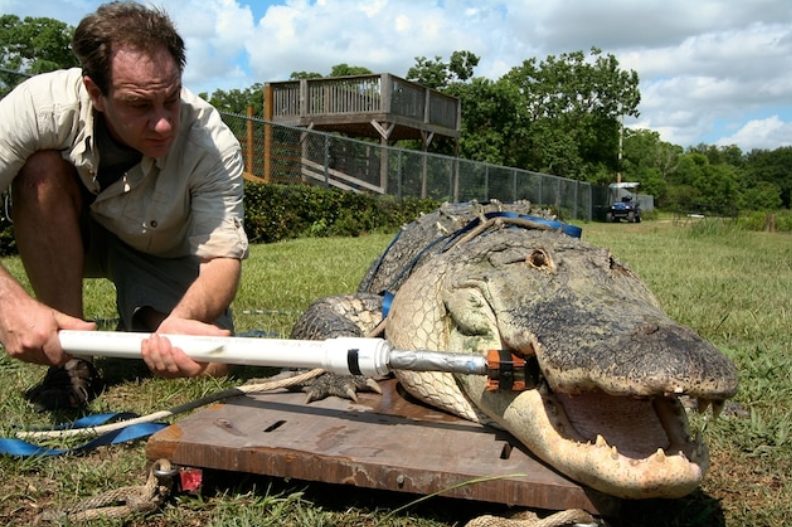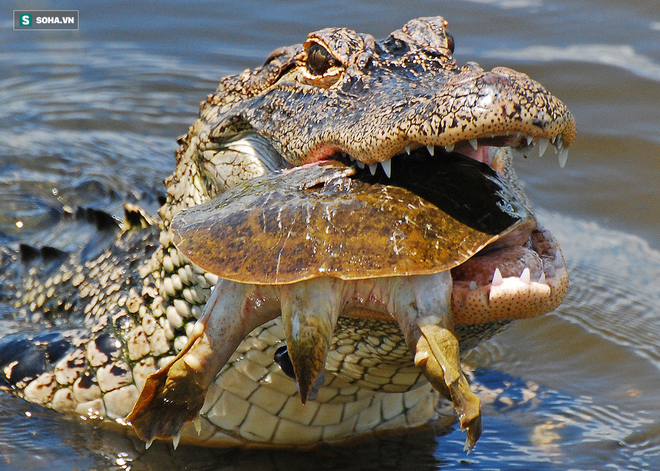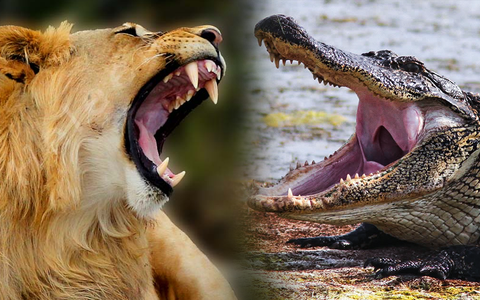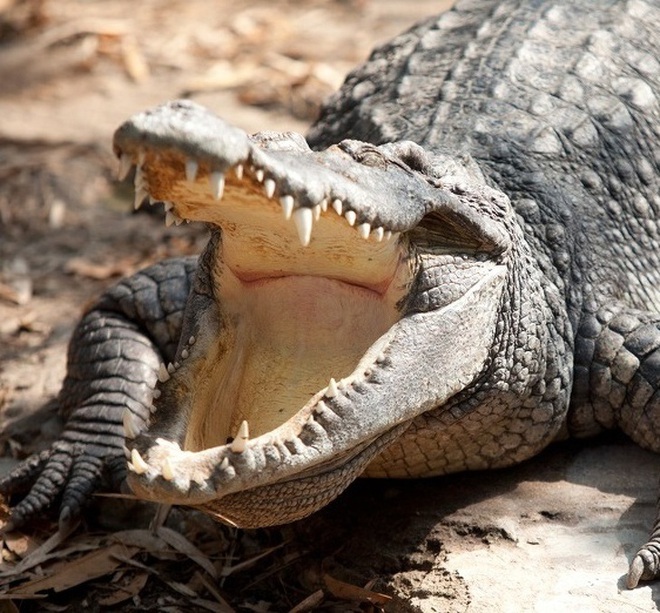Crocodiles may be the world’s champion chompers, killing with the greatest bite force ever directly measured for living animals, a new study says. In fact, their bite forces may rival that of mighty T. rex.
Paleobiologist Gregory M. Erickson and colleagues put all 23 living crocodilian species through an unprecedented bite test. The “winners”—saltwater crocodiles—slammed their jaws shut with 3,700 pounds per square inch (psi), or 16,460 newtons, of bite force.

By contrast, you might tear into a steak with 150 to 200 psi (890 newtons). Hyenas, lions, and tigers generate around 1,000 psi (4,450 newtons).
And while a 2008 computer model estimated that a 21-foot (6.5-meter) great white shark would produce nearly 4,000 psi (17,790 newtons) of bite force, that figure hasn’t been directly measured.
Erickson and colleagues did physically measure the bites of several 17-foot (5.2-meter) saltwater crocs—as well as Nile crocodiles, alligators, caimans, gharials, and other crocs, some for the first time ever.

The team spent countless hours wrestling with the reptiles at Florida’s St. Augustine Alligator Farm Zoological Park and getting them to bite a force transducer—a “very expensive, very durable, waterproof bathroom scale that’s padded with leather.”
“The testing is like dragon slaying by committee, often involving ten or more people to test a single animal,” said Erickson, of Florida State University.
For every croc species, the transducer registered impressive power, suggesting that a big bite is at the heart of what it means to be a crocodilian, according to Erickson.
“That’s why I think they’ve been so successful,” he said. “They seized on a remarkable design for producing bite force and pressure to occupy ecological niches on the water’s edge for 85 million years, and no one else evolved that could wrest those niches from them.”
Surprisingly, at least to Erickson, variations in the bite forces of croc species turn out to be largely based on body size. In many animal groups this variation is tied to differing jaw shapes and tooth forms, but those features didn’t much affect the croc chomps in the team’s tests.

This suggests crocs were big biters from the dawn of their evolutionary line, said Erickson, a grantee of the National Geographic Society’s Committee for Research and Exploration. (The Society owns National Geographic News.)
“I think the most primitive development of the crocs was basically as a force-generating machine,” Erickson said. Variations in snouts and teeth arose later, fine-tuning that powerful bite for prey ranging from fish and snakes to birds, mammals, and even insects. (Rare Pictures: Crocodile Attacks Elephant.)
“Think of a Weed Eater with a big engine that has different attachments, like a grass cutter or a tree trimmer. During evolution [crocs] basically played around with those sorts of attachments,” said Erickson, who led the new study, published Wednesday in the journal PLoS ONE.

In a typical croc environment, “big game comes to the water’s edge, mollusks grow there, birds land—and anything that’s around that water, they can eat it.”
Paleobiologist Laura Porro, who wasn’t involved in the new research, added, “People have been talking about how differences in snout shape and tooth shape and diet may impact crocodilian biomechanics, but no one has been able to collect all these data. It’s extraordinary.”
Mind-Boggling Bites of Crocs Past
In addition to shedding light on living crocs, the new data could illuminate the extinct animals at the roots of the croc family tree, said Porro, of the University of Chicago, who studies live alligators but also models biomechanics of extinct reptiles.

“This kind of work with living animals can help us try to validate our models,” she said. “And I think you could definitely extend this model to the fossil crocs, even the giant ones, that look relatively similar to modern crocs.”
Erickson and team have already done some such scaling—producing an image of a truly ferocious ancient croc.
“We tested several 17-foot [5-meter] saltwater crocs,” he said. “If you scale the results up to 20-footers, you get estimates of 7,700 pounds [34,250 newtons], which is the low end of T. rex bite-force estimates.
“So if you want to see what T. Rex bite force looks like, go look at one of these crocs.”
Furthermore, by Erickson’s calculations, the extinct, limousine-size Deinosuchus, or “terrible crocodile,” had an estimated bite force as high as 23,100 psi (102,750 newtons)—greater even than new estimates that put T. rex’s bite at 12,814 psi (57,000 newtons).
“It’s mind-boggling to think about that one,” he said.

The University of Chicago’s Porro noted that no Tyrannosaurus rex muscle survives, so estimates for the dinosaur’s bite force are based on its body size, wide skull and short snout.
Those T. rex bones look capable of a stronger bite than any croc’s, Porro said. “But then again, if you dissect a croc’s head, it’s amazing just how much muscle mass they have. They have huge jowls … all jaw-closing muscle, so who knows?” she said. “Maybe it’s a matter of crocs just having more muscle.”
We may never know for sure whether a croc or a tyrannosaur was the world’s all-time champion chomper (and in any case, a giant prehistoric shark likely has both beat).
“There is always going to be some uncertainty,” Porro said.
Modern crocs are remarkably similar to prehistoric ones, which in some ways makes things easy for ancient-croc researchers, she noted. But “we have nothing today that looks very much like a T. rex.”




